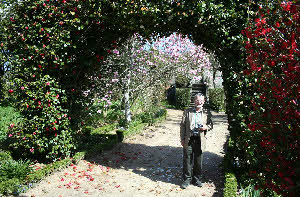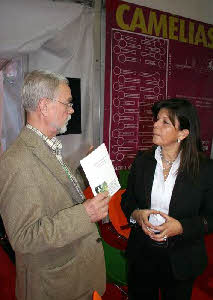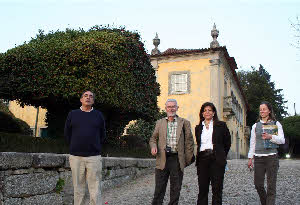Galicia and Porto
Special travel destinations
Max Waldemar Hansen
There are still places in Europe with camellias I have not yet discovered.
At the ICS Congress 2008 in Cornwall a delegation from Pontevedra/Spain proposed to hold an ICS Congress in 2014 together with the ICS region of Porto/ Portugal.
Since I had never been in this area before when camellias were in flower I really wanted to visit these places.

Dr Carmen Salinero Corral, ICS director of Spain, had invited the ICS president Pat Short, her husband Herb and me, [at that time] the ICS-Vice president for Europe, to a meeting to Ponteverda to discuss the timing and to show us the most beautiful camellias in this area.
We were met at the airport by Maria Gonzalez Garcia and Pila Velar, two of Dr. Carmen Salinero’s colleagues.
I was soon impressed by the wonderful countryside and understood why the Spanish and Portuguese wanted to invite ICS members to a Congress there.
First of all it is a region favoured by its climate. In March there is no tourist hustle and bustle, and temperatures are moderate. For people who can take a holiday at this time the region is ideal for recreation.
For camellia lovers there is an abundance of camellia blooms in gardens and parks. One could think that they were endemic here and did not have their origin in distant Asia.
It became clear to me that Shigeo Matsumoto from Japan had been truly convinced of the camellias’ beauty when writing his report on Galicia (ICS Journal 2007) not from an aspect of mere Japanese politeness.
The scenic beauty had already impressed me when I travelled to Santiago de Compostella in 1978. In that summer I did not recognise any camellias.
This time however the the flowers were prominent in all gardens amd public parks.
The year before I had gone with a small group of camellia experts from China, Japan, Taiwan, Italy and England to a remote corner of Yunnan/China to see old reticulatas that had been discovered two years before. They were mighty trees over 250 years old. What a great experience for me! Never had I expected to see such great and wonderful trees here in Galicia, which far exceeded my expectations.
First we visited the large Rio Tollo nursery in Barrio de Tollo with thousands of camellias in all sizes, and even azeleas, rhododendron and other ornamental shrubs.
After check-in at the hotel in Pontevedra we went on a tour of the town and discovered the square in front of the town hall surrounded by large camellia trees. Pontevedra is a small town in the south west of Galicia. It has a large medieval district. On our way back to the hotel we noticed blue lights in the pavement in one street. They mark the Way of St. James (Camino de Santiago) which leads through Pontevedra to Santiago de Compostella.
Early the next morning, a bit chilly but with the sun at the horizon, we were taken a long way to Pazo de Marinan near La Coruña. This impressing park we saw lots of old camellias, simple-flowering japonicas, enormous trees and large ornamental boxwoods. Besides Marinan we visited different mansions with delightful parks with camellias along the roads of Galicia’s west.
The following morning we drove to Pazo de Lourizan, a garden of 54 ha. It is an important botanic garden with both endemic and exotic plants. The old camellia cultivars were planted in the 19th century. After this visit we were able to have a look at the institute of Dr. Carmen Salinero and Pedro Mansilla. Their studies on plant research have a wide range including a camellia gene bank. They conduct research on Ciborina and other plant diseases.
Around noon time we were taken to Castelo Soutomaior to meet the ICS delegation from Porto – Joanna Andresen Guedes (ICS Director Portugal) and José Horácio Garcia Costa, [the then] Membership Representative ICS Portugal) – and José Juan Durán (Vicepresidente de la Deputacion de Pontevedra) and Vanessa Diz (Turismo Rias Baixas).
We were to determine the date and the process of the 2014 ICS Congress and which public institutions could be used. After the talks and a wonderful lunch we strolled through this great park with its superb landscape. Camellia trees with enormous trunks were in full flower. Soutomaior Park with its nearly 62 acres is one of the most important botanic gardens in Galicia.
More than 100 camellia varieties and ancient chestnut trees from five continents grow together with palm and orange trees, eucalyptus and magnolias. The castle originates from the 12th century. In 1982 it was taken over by the provincial government which restored the building that is now being used for cultural events.
Together we drove on to visit wonderful gardens with old mansions and especially camellias. We all agreed that there could be no better place for an ICS Congress.
The following day the Shorts departed for Paris, and I was lucky to be taken to Porto by two ladies.
On the way we made a break in Vigo, the largest city in Galicia, that has the impressive park ‘Castrelos’, laid out in French and English style and with a town museum. It displays archeological exhibits from the years 1500-600 before Christ. In this park one can find a fine camellia specimen, known as “Methuselah”, a C.japonica with pink flowers. It is counted among Galicia’s oldest camellias.
On we went to Porto. Thanks to EU aid, the road system has been well constructed.
There weather was fine, even warm for this time (March 13, 2009). The two ladies accompanying me took me safely to the Hotel “Boa Vista” in Porto. Soon Joana Andresen Guedes, ICS director of Portugal, picked me up for a trip. We went to a pizzeria first and sat on the balcony overlooking the harbour. Porto is picturesquely situated in the Douro valley. From every corner, Porto offers a romantic view. Then we first went to the family seat of Guedes-van Zeller, the Quinta de Santo Ignácio, a 17th century estate, renovated with great care by the family. Rooms are furnished stylishly, and each of them always has fresh flower bouquets, as if guests could arrive any minute.
Behind the house lies the wonderful garden subdivided into different areas each with its own subjects. From this point one has an impressive view of the flowering garden in whose centre is a water basin made from stone.
In the background of the garden one can see the so-called “treeland” with the largest collection of camellias in Portugal. One can wander around this place for hours and always find something new, e.g. a huge number of different eucalyptus. One of them, Eucalyptus oblique, has a trunk circumference of 8.15 m measured at 1.30 m height and is 50 m tall. The site also includes a zoo with interesting animals.
Joana still had to cut camellia flowers for an exhibition in Celorico the following day. In this garden I discovered a C.japonica ‘Waratah’.

Saying good-bye was not easy for me but we still wanted to visit Joana’s friend, Isaura Allen at Quinta Villard-Allen. Since it was turning dark I could only get a faint idea of the camellia treasures on the large property. But I was able to see more of the interior over a glass of port wine. It was furnished with 19th century treasures. I hope to visit here once again during the day.
The following morning Isa picked me up at the hotel to see the camellia flower show in Celorico. The weather was nice once again. The backcountry is densely populated and has been developed, but the farther you go the more you can see of the unique landscape. In the mountains there are picturesque places. Soon we arrived at Celorico, a small village with a nice pleasure ground with many old camellia trees.
Below that area they had put up long white tents with large tables displaying camellia flowers. It was splendid. Many breeders and camellia friends from the region and neighbouring Spain had exhibited camellia flowers of the most differing forms. In prior years, the camellia friends had exhibited their flowers beneath the park’s trees. It was cooler there and the flowers lasted longer. However, politicians did not allow this anymore.

Here I met Horácio again and Clara Gil de Seabra with her husband. I was looking for Jorge Bastos who would be able to graft a slip of ‘Waratah’ which I had received from Joana on a suitable stock. He soon arrived and we drove to his nursery to look for this stock. Near the road I saw a large ‘Waratah’ full of flowers. I asked him if he did not have a small plant that I could take with me on the airplane. He brought a plant with a height of 1.2 m. I doubted if I could take that into the plane, but could not resist. He gave it to me as a present, a piece of luck.
We then went to a wonderfully situated restaurant for dinner and from there to Clara and Gil de Seabra’s estate. I was lucky again. The physical structure dates back to the 17th century. It had been restored with great care and was very homey. One could think Don Quixote would arrive soon.
The house is surrounded by a grandly designed park. Some of the countless camelias are standing in full shade of large conifers. Others are in full sunshine. Some leaves of several camellias showed small cracks from frost damage. This is a wonderful collection of mainly Portuguese camellias. Portugal has its own remarkable varieties. Some of these can be found in other countries with a different name, having grown apart, because breeders have pursued their own perceptions of the ideal. Form and colour diverged more and more from the original plant so that no comparisons were possible, especially in regions far from each other.
It was getting dark by now and Isa Allen took me back to the hotel. The following morning I was picked up again by Horácio, a true camellia friend, and taken to the Crystal Palace, an exhibition hall in Porto. Here the grand camellia shows take place. The building is surrounded by a wonderful park with its superb views on Porto, the river Douro and the large bridges.
He showed me some more of his favourite places before returning to Celorico. From there we visited some other estates with camellia collections and nice gardens. One special place to visit is Bastos de Campo. Anybody not having been in this region would be astonished. I have seen camellia hedges in New Zealand and Japan planted against erosion and strong winds. But here it was different: camellias are shaped to form huge arbours that provide shade for walks where people can stroll and drink tea at teahouses. Not having suffered from strong winds, the camellias’ leaves were dark green and full of flowers. We drove on to visit more interesting places and had lunch at a nice restaurant.
Then Horácio wanted to show me something special. He pointed out to me the beauty of the surrounding landscape. On small paths we reached the peaks of the mountains and finally arrived at his own finca. It had been an old abandoned finca nearly falling apart, but lying idyllically on a steep mountain slope covered with numerous trees, flowers and shrubs. It is his intention to restore this place. He has a huge amount of work ahead of him.
We then drove back to Porto along small roads on the mountain ridge and visited more gardens. Shortly after 21:00 h we arrived at the hotel. It had been a long day and Horácio had made every effort to give me an understanding of the beauties of the landscape.
The following morning Joana picked me up again. We visited the Botanic Garden of Porto in which theme gardens are divided by four metre high camellia hedges. In one of these hedges I saw C.japonica ‘Sophia’ which I had been given on the Azores to present to the zoological and botanical garden Wilhelma in Stuttgart.
After a superb lunch in the Guesdes family town house we drove to Quinta da Aveleda, another seat of the Guedes family. Quinta Avelada is in several travel guides as a place of interest. Aveleda Park owes its existence to a family whose love for nature in its true simple way has always been their prime principle. Not just for them the park was a hideaway on hot summer days in the shade of age - old trees. The park and its gardens developed in accordance with the changing fashions and personal influences of its owners into a true piece of art, unfinished and open to everybody.
Here you can walk for hours on end and enjoy the old trees, the hidden ponds with its swans and romantically designed paths. Camellia friends can admire a large selection of camellias. The highlight is an old camellia with a trunk circumference of 2.60 m at breast height. Joana suddenly jolted me out of my dreams. She had to take me back to the hotel. Now I had to prepare my ‘Warantah’ for the air trip by forcing it into a plastic bag only 50 cm high.
I had been invited to have dinner with Clara Gil and her family. She had prepared a delicious meal with a surprise for me. Since I suffer from a rice allergy I got roast chestnuts to go with the meat, a truly fine combination. We had a very enjoyable evening. As a farewell gift I received a bottle of 1952 port wine.
On my last day Clara’s son drove me to the airport and helped me take my camellia and luggage on board the plane
This journey makes it clear to me that there are still many treasures to discover in Europe and that this area is particularly suitable for spending a holiday in the spring. The climate is mild, and the salt breeze is good for one’s health.
My special thanks go to Dr. Carmen Salinero, Pedro Mansilla and team, Joana Andresen Guedes, Isaura Allen, José Horácio Garcia Costa and Clara Gil de Seabra with her husband and Jorge Bastos. They made possible this wonderful journey to all these beautiful places with its marvellous camellias.
Web design by Tribal Systems
